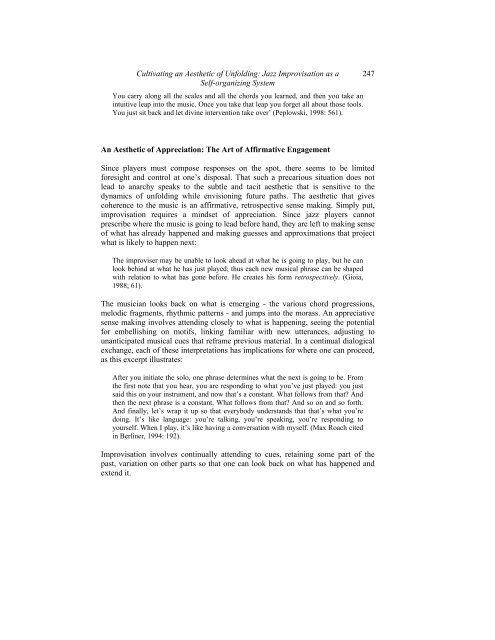Cultivating aesthetics - iSites
Cultivating aesthetics - iSites
Cultivating aesthetics - iSites
You also want an ePaper? Increase the reach of your titles
YUMPU automatically turns print PDFs into web optimized ePapers that Google loves.
<strong>Cultivating</strong> an Aesthetic of Unfolding: Jazz Improvisation as a<br />
Self-organizing System<br />
You carry along all the scales and all the chords you learned, and then you take an<br />
intuitive leap into the music. Once you take that leap you forget all about those tools.<br />
You just sit back and let divine intervention take over’ (Peplowski, 1998: 561).<br />
247<br />
An Aesthetic of Appreciation: The Art of Affirmative Engagement<br />
Since players must compose responses on the spot, there seems to be limited<br />
foresight and control at one’s disposal. That such a precarious situation does not<br />
lead to anarchy speaks to the subtle and tacit aesthetic that is sensitive to the<br />
dynamics of unfolding while envisioning future paths. The aesthetic that gives<br />
coherence to the music is an affirmative, retrospective sense making. Simply put,<br />
improvisation requires a mindset of appreciation. Since jazz players cannot<br />
prescribe where the music is going to lead before hand, they are left to making sense<br />
of what has already happened and making guesses and approximations that project<br />
what is likely to happen next:<br />
The improviser may be unable to look ahead at what he is going to play, but he can<br />
look behind at what he has just played; thus each new musical phrase can be shaped<br />
with relation to what has gone before. He creates his form retrospectively. (Gioia,<br />
1988; 61).<br />
The musician looks back on what is emerging - the various chord progressions,<br />
melodic fragments, rhythmic patterns - and jumps into the morass. An appreciative<br />
sense making involves attending closely to what is happening, seeing the potential<br />
for embellishing on motifs, linking familiar with new utterances, adjusting to<br />
unanticipated musical cues that reframe previous material. In a continual dialogical<br />
exchange, each of these interpretations has implications for where one can proceed,<br />
as this excerpt illustrates:<br />
After you initiate the solo, one phrase determines what the next is going to be. From<br />
the first note that you hear, you are responding to what you’ve just played: you just<br />
said this on your instrument, and now that’s a constant. What follows from that? And<br />
then the next phrase is a constant. What follows from that? And so on and so forth.<br />
And finally, let’s wrap it up so that everybody understands that that’s what you’re<br />
doing. It’s like language: you’re talking, you’re speaking, you’re responding to<br />
yourself. When I play, it’s like having a conversation with myself. (Max Roach cited<br />
in Berliner, 1994: 192).<br />
Improvisation involves continually attending to cues, retaining some part of the<br />
past, variation on other parts so that one can look back on what has happened and<br />
extend it.
















